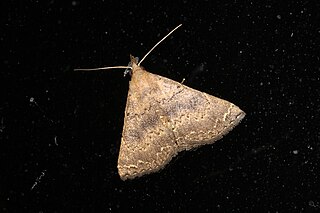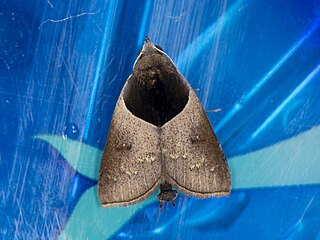
Callopistria maillardi is a moth of the family Noctuidae. The species can be found throughout central, eastern and southern Africa, including the islands of the Indian Ocean, Yemen, Chagos islands, Pakistan, India, Sri Lanka, southern China, in Hawaii, Hong Kong, New Zealand, the Society Islands, Sulawesi, as well as Queensland in Australia.

Callopistria is a genus of moths of the family Noctuidae. It was described by Jacob Hübner in 1821.

Carmara is a monotypic moth genus of the family Noctuidae. Its only species, Carmara subcervina, is found in Sri Lanka, Japan, Taiwan, Borneo and Australia. Both the genus and species were first described by Francis Walker in 1864.

Belciana biformis is a moth of the family Noctuidae first described by Francis Walker in 1858.
Episparis liturata is a moth of the family Noctuidae first described by George Hampson in 1893. It is found in India, Sri Lanka, Java, Borneo, Myanmar, China and Thailand.
Ctenoplusia fracta is a moth of the family Noctuidae first described by Francis Walker in 1858.
Scriptoplusia nigriluna is a moth of the family Noctuidae first described by Francis Walker in 1858. It is found throughout the Oriental tropics of India, Sri Lanka, Bangladesh, Japan and the South East Asian region.

Polytela gloriosae, the Indian lily moth or lily caterpillar, is a moth of the family Noctuidae. The species was first described by Johan Christian Fabricius in 1781. It is found in Sri Lanka, India and probably in Indonesia.
Adrapsa geometroides is a moth of the family Noctuidae first described by Francis Walker in 1858. It is found in Indian subregion, Sri Lanka. to Sundaland and New Guinea.
Hadennia jutalis is a moth of the family Noctuidae first described by Francis Walker in 1859. It is found in India, Sri Lanka, Thailand, Malaysia, Laos, Vietnam, Myanmar and the Andaman Islands.

Progonia oileusalis is a species of moth in the family Noctuidae first described by Francis Walker in 1859. It is found in Sri Lanka, Borneo, India, Taiwan, Japan and the Philippines.

Anigraea cinctipalpis is a moth of the family Noctuidae first described by Francis Walker in 1865. It is found in Indian subregion, Sri Lanka, Malaysia, Borneo, Philippines, New Guinea and Australia.
Penicillaria lineatrix is a moth of the family Noctuidae first described by Francis Walker in 1858. It is found in India and Sri Lanka.
Stenopterygia subcurva is a moth of the family Noctuidae first described by Francis Walker in 1857. It is found in Sri Lanka.
Callopistria apicalis is a moth of the family Noctuidae first described by Francis Walker in 1855. It is found in the Indian subregion, Sri Lanka, Sundaland and the Philippines.
Feliniopsis opposita is a moth of the family Noctuidae first described by Francis Walker in 1865. It is found in Kenya, Somalia, Sri Lanka and India.
Leucania roseilinea, the grain army worm, is a moth of the family Noctuidae. The species was first described by Francis Walker in 1862. It is found in Sri Lanka, Myanmar, Sundaland, the Philippines to New Guinea.
Mythimna hamifera is a moth of the family Noctuidae first described by Achille Guenée in 1852. It is found in Sri Lanka, Japan and Borneo.

Acidon nigrobasis is a species of moth in the family Erebidae first described by Charles Swinhoe in 1895. It is found in India, Sri Lanka, and Borneo.

Earias cupreoviridis, called the cupreous bollworm as a larva, is a moth of the family Nolidae. The species was first described by Francis Walker in 1862. It is found in African countries like Botswana, the Democratic Republic of the Congo, Eritrea, Ethiopia, the Gambia, Kenya, Nigeria, Sierra Leone, South Africa, Togo, Uganda, Zimbabwe to Asian countries like India, Sri Lanka, China, Japan, Korea, Philippines, Indonesia and Hong Kong.








